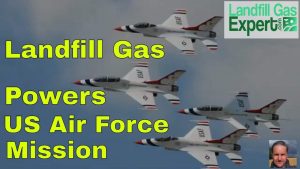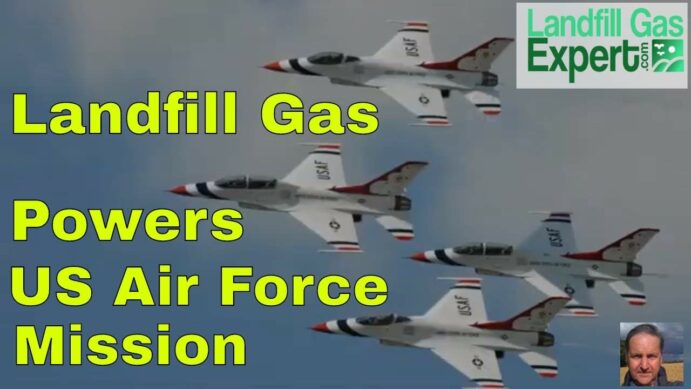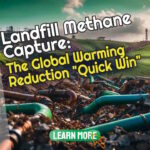All landfills should use the gases from landfills. This is done by installing gas collection systems to avoid as far as is reasonable the emission of methane. Methane is a strong “greenhouse gas”. It produces more than 20 times the global warming effect of carbon dioxide.
“Landfill gas is a complex mix of different gases created by the action of microorganisms within a landfill. Landfill gas is approximately forty to sixty percent methane, with the remainder being mostly carbon dioxide.'
via en.wikipedia.org
Gases from Landfills are the Product of Anaerobic Decomposition
Biogas is produced from biomass through the process of anaerobic decomposition of biomass. Anaerobic bacteria—bacteria that live without the presence of free oxygen—occur naturally in soils, in water bodies such as swamps and lakes, and in the digestive tracts of humans and animals. These bacteria eat and break down, or digest, biomass and produce biogas. Biogas is composed mostly of methane and carbon dioxide.
The gas produced by landfills can be used to generate electricity when collected from large landfills. This is recognised by the US military. Watch our video about gases from landfills powering US military bases, in this case the Air Force, by watching our video below:
Composition of the Biogas Gases from Landfills
Methane (CH4) is the same energy-rich compound found in natural gas. The composition of biogas varies from 40%–60% methane to 60%–40% carbon dioxide (CO2), with small amounts of water vapor and other gases.
Biogas forms in, and can be collected from, municipal-solid-waste landfills and livestock manure holding ponds. Biogas can also be produced under controlled conditions in special tanks called anaerobic digesters. Biogas can be treated to remove CO2 and other gases, and it can be used as a fuel just like natural gas. The material that is left after anaerobic digestion is complete is called digestate, which is rich in nutrients and can be used as a fertilizer.
Municipal-Solid-Waste Landfills are the Main Producers of these Gases
Landfills for municipal solid waste are a source of biogas. Biogas is produced naturally by anaerobic bacteria in municipal-solid-waste landfills and is called landfill gas. Landfill gas with a high methane content can be dangerous to people and the environment because methane is flammable. Methane is also a strong greenhouse gas.
U.S. Energy Information Administration (EIA) Landfill Gas Utilization
Regulatory Requirements for Landfill Gas Collection and Control Systems
In the United States, regulations under the Clean Air Act require municipal-solid-waste landfills of a certain size to install and operate a landfill gas collection and control system.
How Burning Landfill Gas Reduces Climate Impact
Some landfills reduce landfill gas emissions by capturing and burning—or flaring—the landfill gas. Burning the methane in landfill gas produces CO2, but CO2 is not as strong a greenhouse gas as methane. Many landfills collect landfill gas, treat it to remove CO2, water vapor, and hydrogen sulfide, and then sell the methane. Some landfills use the methane gas to generate electricity.
Estimated Quantity of Landfill Gas Collected and Flared (Burnt) in 2017
The U.S. Energy Information Administration (EIA) estimates that in 2017 about 282 billion cubic feet (Bcf) of landfill gas was collected at about 370 U.S. landfills and burned to generate about 11.5 billion kilowatthours (kWh) of electricity, or about 0.3% of total U.S. utility-scale electricity generation in 2017. via www.eia.gov
Landfill Odors
Landfills can produce objectionable odors and landfill gas can move through soil and collect in nearby buildings.
Of the gases produced in landfills, ammonia, sulfides, methane, and carbon dioxide are of most concern. Ammonia and hydrogen sulfide are responsible for most of the odors at landfills.
Dangers from the Methane in Landfill Gas
Methane is flammable and concentrations have sometimes exceeded explosive levels indoors.
Methane and carbon dioxide can also collect in nearby buildings and displace oxygen.
This facts sheets are available online which provide information on what measures can be taken to prevent gases from leaving landfills and entering off-site structures and how building owners can reduce landfill gas collection indoors, particularly in confined areas like basements and crawl spaces.
The New York State View on the Composition and Quantity of Gases Extracted from Landfills
Landfill gas contains many different gases. Methane and carbon dioxide make up 90 to 98% of landfill gas. The remaining 2 to 10% includes nitrogen, oxygen, ammonia, sulfides, hydrogen and various other gases. Landfill gases are produced when bacteria break down organic waste.
The amount of these gases depends on the type of waste present in the landfill, the age of the landfill, oxygen content, the amount of moisture, and temperature. For example, gas production will increase if the temperature or moisture content increases. Though production of these gases generally reaches a peak in five to seven years, a landfill can continue to produce gases for more than 50 years. via www.health.ny.gov
How Much Gas will there be?
The more organic waste present in a landfill, the more landfill gas (e.g., carbon dioxide, methane, nitrogen, and hydrogen sulfide) is produced by the bacteria during decomposition. The more chemicals disposed of in the landfill, the more likely NMOCs and other gases will be produced either through volatilization or chemical reactions.
Generally, more recently buried waste (i.e., waste buried less than 10 years) produces more landfill gas through bacterial decomposition, volatilization, and chemical reactions than does older waste (buried more than 10 years). Peak gas production usually occurs from 5 to 7 years after the waste is buried.
Migration of Landfill Gases

When upward movement is inhibited, the gas tends to migrate horizontally to other areas within the landfill or to areas outside the landfill, where it can resume its upward path. Basically, the gases follow the path of least resistance.
Some gases, such as carbon dioxide, are denser than air and will collect in subsurface areas, such as utility corridors.
Diffusion describes a gas's natural tendency to reach a uni-form concentration in a given space, whether it is a room or the earth's atmosphere. Gases in a landfill move from areas of high gas concentrations to areas with lower gas concentrations.
Because gas concentrations are generally higher in the landfill than in the surrounding areas, landfill gases diffuse out of the landfill to the surrounding areas with lower gas concentrations.
Gases accumulating in a landfill create areas of high pressure in which gas movement is restricted. The restriction is by compacted refuse or soil covers. Other areas of low pressure are also often present in which gas movement is unrestricted. via www.atsdr.cdc.gov
Upgraded Landfill Gas Sold as “Compressed Natural Gas (CNG)” from Landfills
CNG has been used in vehicles for about 30 years, UW-Madison mechanical engineering professor Glenn Bower said. The methane in natural gas is a very harmful greenhouse gas when emitted, but when it's burned in vehicles, it changes into a less harmful carbon dioxide and is considered a cleaner fuel source than gasoline.
“About 30% of the county's fleet is running on CNG”,
Parisi said.
In addition, Kwik Trip's Joel Fasnacht said about 85% of Kwik Trip's fleet uses CNG.
Compressed CNG – What Occurs when the CNG is Not Provided with Added LPG/ High Octane Gas to Raise Calorific Value
Natural gas that is sourced from the ground has a higher ratio of methane than the gas sourced from the landfill, which Bower said had made it a difficult source for use in vehicles. Unless a vehicle is equipped with sensors that can accurately detect methane concentration, the vehicle may not use the proper amount of fuel compared to the oxygen intake.
BIOFerm's is one example of a facility which we are told overcomes that challenge of gas sourced from landfills by constructing several cleaning steps to reach a higher concentration of methane.
Various chemicals and particles are stripped away from the gas as it passes through several massive tanks — some up to 60 feet tall — before it is injected into the pipeline, president and CEO Nadeem Afghan said. via madison.com
Landfill Gas Use and Origins
Landfill gas use is the collection and treatment of methane or other gaseous substances from the decomposition of waste in a landfill to create power, heat, and energy. In addition to fossil fuels and farming, municipal solid waste (MSW) landfill gas was third in the world as the contributor to methane emissions as a greenhouse […]
Landfill Methane Capture: The Global Warming Reduction “Quick Win” You've Never Heard Of
Concerned about the menacing effects of landfill gas on our environment? You're not alone, but it's not as bad as it might be where a landfill has a well-engineered Landfill Methane Capture system installed. In fact, we go so far as to say that landfill methane capture and utilisation is the global warming reduction “Quick […]
Fundamentals of Landfill Gas
Understanding the fundamentals of landfill gas is crucial for environmental researchers, waste management professionals, and many others engaged in addressing climate change. A natural byproduct of organic material decomposition in landfills, this flammable gas plays a substantial role in global warming due to its composition. While not odorous if well managed it is closely associated […]
Landfill Gas Flares – Selection Installation And Maintenance
Landfill gas flares are now destined to be installed in a lot more landfills globally after COP26. This article is intended to help the anticipated influx of industry newcomers with their Landfill Gas Flare selection, installation, and maintenance. One of the international pledges made during the UN International Climate Change Conference 2021 otherwise known as […]








